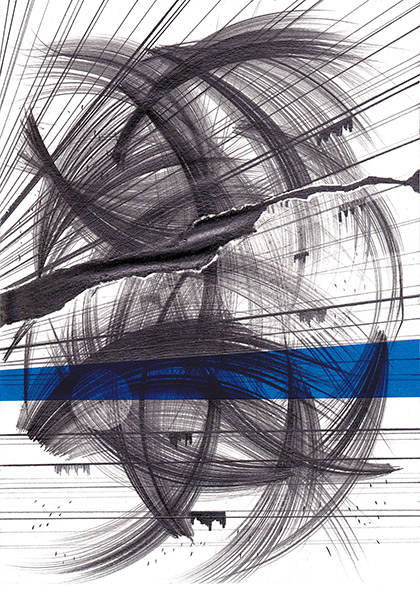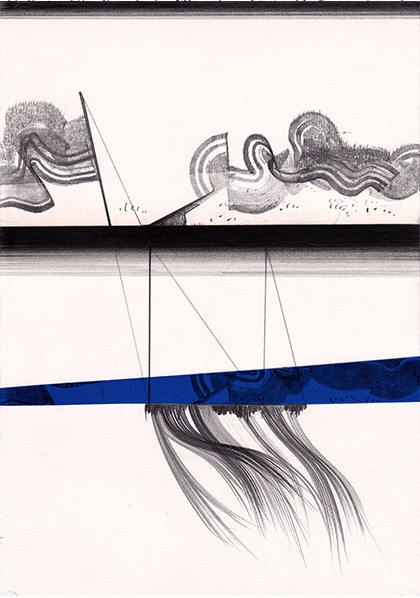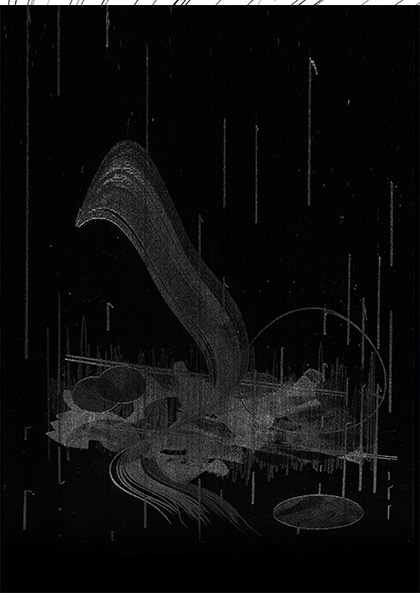You are here: American University College of Arts & Sciences American University Museum 2015 Transcription of Blue: Guy Goldstein
Contact Us
Media Contact: Rebecca Basu (202-885-5950) basu@american.edu
Contact:
Media Contact: Rebecca Basu (202-885-5950) basu@american.edu
Transcription of Blue: Guy Goldstein April 4 through May 24, 2015

Guy Goldstein, Details from the series Partitura for Blue Noise, 2013.
Graphite and vinyl on paper, drawings transformed to sound and videos, 12 x 8 in.
Courtesy of the Artist.

Guy Goldstein, Details from the series Partitura for Blue Noise, 2013.
Graphite and vinyl on paper, drawings transformed to sound and videos, 12 x 8 in.
Courtesy of the Artist.

Guy Goldstein, From the series Minus Green, 2015.
Pigment inkjet print on cotton paper, sound transformed to an image, 21.7 x 15.8 in.
Courtesy of the Artist.
Exhibition Overview
As both a visual artist and musician, I am fascinated by the transitions between media-attempts to convert and translate actions through one medium to another. This project continues my ongoing occupation with the relationship between sound and image.
In this body of work, I convert drawings to sound, and vice versa, using software that is based on an old cumbersome machine from 1940s Russia. The software makes it possible to obtain a visible image of a sound wave. It also synthesizes a sound from an artificially drawn sound spectrogram.
First, I draw "sonic codes" which look like scores or large scale drawings that represent the spectrum of the frequencies in a sound. I then convert these drawings to sound. The software creates animated films with the images from the drawings and its own sound. My process references old school sound artists and sound animators from the 1930s, like Arseny Avraamov (Russia) and Oskar Fischinger (Germany). It also references Norman Mclaren (Canada) from the 1950s, who tried to draw sound, animate graphic shapes into sound, and create animated films with the results.
Once I have the sound of the drawings, I perform it by playing the bass. Sometimes I invite other musicians to perform and play live with the drawing's sound in the background. Thus, a dialogue of harmony, melody, rhythm, and sound is created out of acoustic, digital, and analog instruments and tools.
While creating the drawings, I use various drills, equipped with graphite and pencils instead of drill bits. The sound and vibrations of the drill are transmitted onto the paper as rich patterns and textures. I then use tape to transfer these textures to a different part of the drawing or to other drawings. The graphite sticks to the tape so that I can arrange the textures on the drawing. I edit and layer the tapes as voiceprints, graphic notations, or spectrographs.
Finally, I convert the sound of the drawings back to images again, using the same software. The final result is a ghost of my images, inverted black and white distortions of my original drawings.
My works do not reveal the tools with which they were created. The viewer can "see" the music, hear the sound, feel the frequency through the drawings, and can recognize a process the work has gone through, but the viewer cannot name the tools or the techniques I used.
My tools are now more focused and I approach my art with more simplicity. This allows me to create a language that, in time, becomes clearer. The more I create and "sharpen" my tools, the more I can put together meaningful combinations of visual, conceptual, and emotional experiences.
-Guy Goldstein from an interview with Barbara London, a New York-based curator and writer at Brooklyn Rail
Supported by OUTSET.
